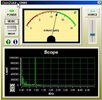Yes. All of the CB finals, AM and SSB, use the same leg configuration. It can be also used for the MRF 477, 497 finals if you know the leg configuration and get the right legs in the right holes, EBC CBE..........Some of the older rigs used a different type of final but again if you know which leg is the base, collector, and emitter and get them in the right hole. This works as a quick go no go test along with a wattmeter. Things get hot in a hurry without a heat sink!
In testing a "real" 2sc2166 will show 4 watts, a fake less than 1 watt.
I have even tested amplifier finals in this. Soldered wires on the tabs and plugged them in. I don't do that anymore as I was at a swap-meet in the San Diego CA area 30~~40 some years ago and bought a 2sc2879 final type tester. It has a single amplifier board with adjustable caps, a cut out for the transistor to be pushed against the heat sink along with Teflon pads to make contact on the transistor connections to the board. It has a mechanism like a re-loader jig to hold it all in place when testing. The adjustable caps make it so it will test all different transistors, MRF455.........2290....It will even test the old stud mounted ones by turning up side down. There is a hole in the ram for the stud to go into. Someone thought this out when it was made. Being in the San Diego area where I bought it I suspect the guy's name was Merit.....




